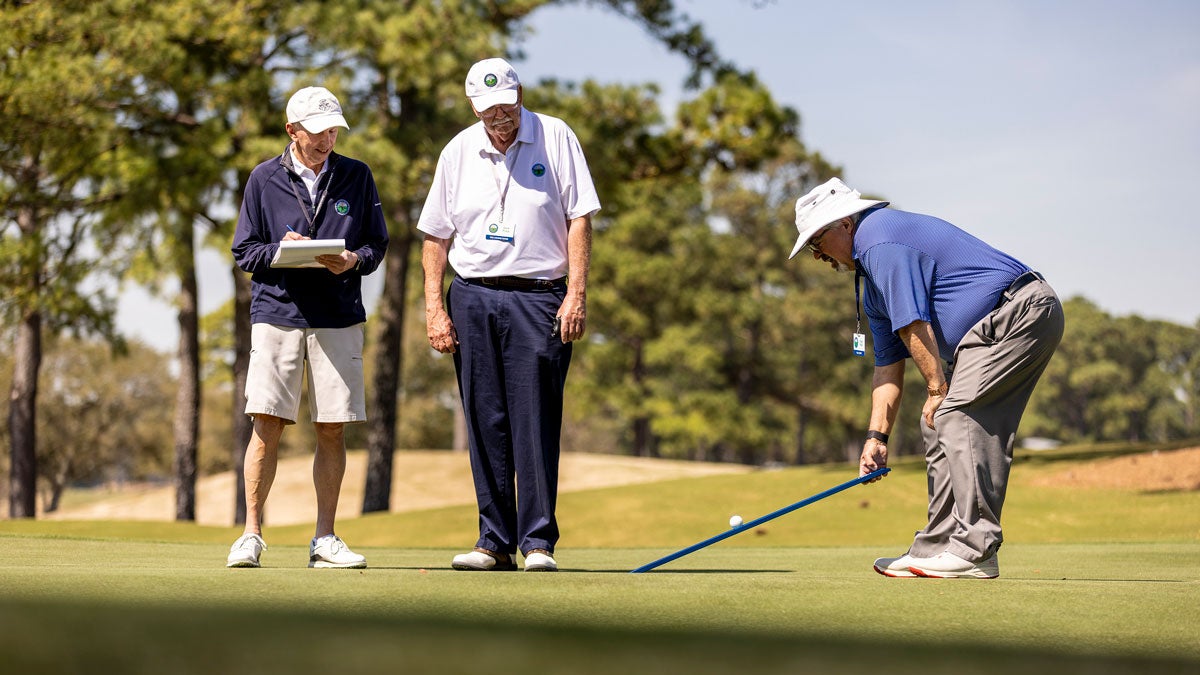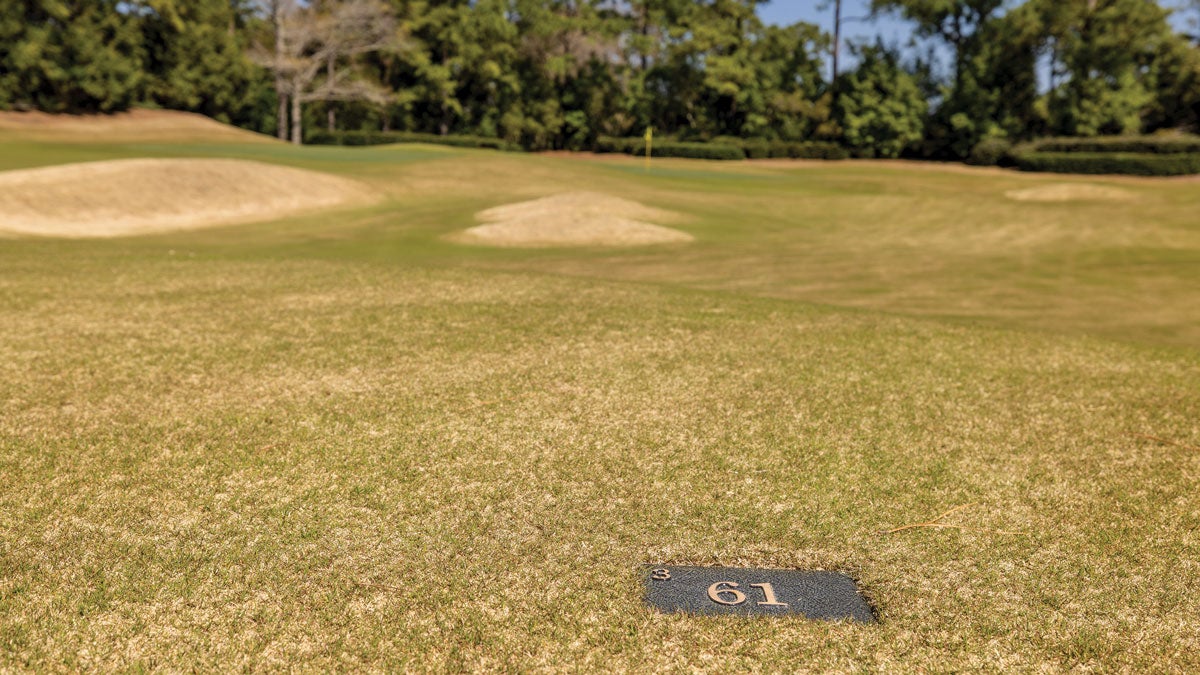Golf
Why the short-course rating movement is such a big win for golfers

Courses that measure at least 1,500 yards for 18 holes or 750 yards for nine holes are now eligible to be rated.
Kyle LaFerriere/USGA
This content was first published in Golf Journal, a quarterly print publication exclusively for USGA Members. To be among the first to receive Golf Journal and to learn how you can ensure a strong future for the game, become a USGA Member today!
The city of Wilmington on the North Carolina coast is home to a century-old Donald Ross course (Cape Fear Country Club) and a 25-year-old Tom Fazio design (Eagle Point Golf Club) that sits about 8 miles north of the city. Both facilities are augmented by nine-hole par-3 courses, each of which was visited in March for the first time by Greg Kelly, the director of Course Rating for the Carolinas Golf Association.
Kelly’s charge: Walk the courses, evaluate them, and feed the resulting data into Course Rating System formulas to produce a Course Rating and Slope Rating for each set of tees. Starting in 2024, the World Handicap System (jointly governed by the USGA and the R&A) lowered the minimum length so that courses that measure at least 1,500 yards for 18 holes or 750 yards for nine holes are now eligible to be rated and golfers can post their scores in the World Handicap System.
“Our course is packed to capacity, and the par-3 course gives beginners and juniors a place to learn the game and its etiquette and feel more comfortable before moving to the big course,” says Chris Byrd, Cape Fear’s director of golf. “Now they can post a score and start tracking their progress. That’s a big development.”
Adds Billy Anderson, director of golf and general manager at Eagle Point, “Most of our play on the short course is people playing an extra nine at the end of the day. But who knows? Maybe nine holes added to the member-guest? There are a lot of things we might do.”
Three thousand miles to the west in California, par-3 and short courses are reaping similar benefits.
Gena Webb started work as general manager at Rancho Carlsbad Golf Course just north of San Diego in 2016 and wanted to get a rating and slope for the 18-hole layout comprising one-shot holes from 78 yards to 171 yards from the back tees. But since its overall length was 1,983 yards, it didn’t meet the 3,000-yard minimum required prior to 2024.
“Our golfers are excited; having the ability to post scores is awesome,” said Webb. “I have always fought the ‘pitch-and-putt’ label. The ability to hit approach shots and work on your short game here is as good as a regulation course. Having a course rating and the ability to participate in the handicap program makes it official.”
In Palm Desert, 100 miles to the northeast, the snowbirds at Portola Country Club are stoked that the scores they post during their six-month winter forays will count toward the handicaps that they’ll carry back to Oregon, Washington, Montana and even Canada during the summer.
Bob Haueter, the handicap chairman of the club tucked into a 55-and-older housing community, welcomed course-rating officials from the Southern California Golf Association (SCGA) to the par-54 layout in the fall of 2023.
“It was fantastic news,” he said of learning of the expanded rating criteria. “We have always had the feeling that we have this beautiful golf course that’s much tougher than it looks, but we weren’t in the SCGA and there was no way of equating our course to other courses. It’s such a nice thing to enter your scores, enter your statistics, and see them change in real time.”
From east to west and all points in between, USGA officials and their network of Allied Golf Associations are heartened by the reaction to this effort to make the game more inclusive.
“Previously, there were about 600 par-3 and short courses that didn’t qualify,” says Scott Hovde, the USGA’s director of course rating. “Short courses are a growing market. There are a lot of players at the beginning or end of their golf career who want to keep playing, and we want to be more inclusive, get as many scores and players as possible. It’s the way the game is moving.”

Kyle LaFerriere/USGA
In 2020, the USGA and the R&A brought all handicap systems under the umbrella of the World Handicap System, which allows players to compare themselves with more precision and makes handicaps portable across the globe.
With the explosion of the game’s popularity coming out of the Covid-19 pandemic and the proliferation of alternative means to enjoy it, adjusting the course rating parameters made perfect sense.
“During the last 20, 25 years, we’ve seen courses and clubs push traditional limits, whether it’s the number of holes, the types of holes, courses where you play one green from three or four directions,” Hovde says. “We have seen a 10-acre ‘golfscape’ with multiple holes. How do you fit these into the handicap system?
“There definitely is a different atmosphere at these facilities. It’s almost a social outing as opposed to competition or serious golf. Still, people try to shoot the lowest score possible. The trend is growing. These courses are a place for the growth of the game, and we don’t want to be flat-footed.”
California is one of the hotbeds for par-3 and executive courses — from facilities at elite private clubs to stand-alone daily-fee courses to residential communities. One of the most picturesque is the par-3 Cliffs Course at the Olympic Club in San Francisco, with nine holes designed by Jay Morrish and Tom Weiskopf perched above the Pacific Ocean, which recently earned a 56.8 Course Rating and a 107 Slope Rating (blue tees/men) from Northern California Golf Association course raters.
“These courses have unique features — many of them have really small greens, they are walking-only, you see parents with their kids,” says Doug Sullivan of the SCGA. “It’s like a walk in the park and you get to play golf. They bring families together. Expanding the universe for rating purposes is a win-win.”
Sullivan and his team rated about 60 short courses starting last summer through this spring in an area that stretches from San Diego north to Santa Barbara and east to Palm Springs.
“We’ve had a great reception from golf staffs and course operators,” he says. “It’s a way for people who play a short course to keep a handicap and monitor their advancement through the game.”
According to the National Golf Foundation, about half of new course openings since 2014 have been shorter-length facilities. A parcel of just 10 or 12 acres will do the trick, and they are generally walking-only and can be played in an hour or less.

Kyle LaFerriere/USGA
And since clubs such as Pine Valley and Augusta National provide a short course as an amenity to their regulation course, why not?
Augusta National architect Alister MacKenzie designed an 18-hole par-3 course with nine double greens that he termed “approach and putt” to go on land northeast of the clubhouse, but because the club opened in 1933 in the depths of The Great Depression, a companion course was not built until the late 1950s. George Cobb designed the nine-hole layout that was first used for the Masters Par-3 Tournament in 1960. Club founder Bob Jones, who was lukewarm to the idea at first, later said, “I agree completely that the construction of this golf course will be an important contribution to the beauty of the place.”
Ernie Ransome, Pine Valley’s club president, designed its 10-hole short course in 1992 with Fazio, the club’s design consultant, to take pressure off the world-renowned layout designed by George Crump that opened in 1913. Ransome liked the idea of replicating as many of the challenging approach shots as possible.
“I always said I would never build a second course at Pine Valley to compete with the original, but I thought it would be nice to duplicate some of the original holes,” Ransome said. “Tom took it from there and did a wonderful job.”
The short-course revolution has touched nearly every significant golf resort in the nation over the last dozen years, with additions that include Bandon Preserve at Bandon Dunes in 2012, Top of the Rock at Big Cedar Lodge in 2014, The Cradle at Pinehurst in 2017, The Sandbox at Sand Valley in 2018, The Nest at Cabot Links in Nova Scotia in 2020, The Hay at Pebble Beach in 2021 and The Swing at PGA Omni Frisco in 2023.
“When you take strength and length out of the equation, golf becomes much more fun for a vastly expanded group of players,” says architect Bill Coore, who with design partner Ben Crenshaw designed Bandon Preserve and a recent new offering at Streamsong Resort called The Chain.
The Carolinas Golf Association office is in Southern Pines, N.C., just a 4-mile drive from Pinehurst Resort & Country Club and its Cradle course and from Pinewild Country Club and the nine-hole Azalea par-3 course that complements its two regulation courses.
The members at Pinewild have embraced the Azalea’s ranking and assimilation into the handicap system, particularly the members of a group known as the Pinewild Azalea Ladies. The course received a 27.5 Course Rating and 85 Slope Rating for men and 28.5/86 for women.
“Rounds in 2023 were up 50 percent from the year prior, showing the trend of playing executive courses and short courses is on the rise,” says Kyle Kirk, Pinewild’s head professional. “The addition of the Azalea Course being rated will only fuel its popularity.”
Nearby at Pinehurst Resort, The Cradle nears its seventh anniversary of operation and continues to generate a vibe that Golf Channel has described as “the most fun 10 acres in all of golf.” The nine-hole course opened in September 2017 and one of the debut events featured the strains of funk and alternative rock music emanating from speakers near the first tee. One golfer played barefoot, while others played with hickory-shafted niblicks, and most carried three or clubs around in customized Sunday bags.
As course designer Gil Hanse notes, “The operative word with The Cradle is fun.”
It was one of the first courses to be rated by the Carolinas Golf Association when the parameters for short courses changed in 2023.
“We rate the holes just like we would a par 3 on a regulation course,” Greg Kelly says. “We take into account the distance of the approach shot. The Cradle has a lot of character with its green complexes and the bunkering and waste areas surrounding the greens. We treat it like any other golf course – it just has shorter holes.”
Approximately 35,000 rounds were played during its first year of operation, and that number skyrocketed to 65,000 by 2023. A row of Adirondack chairs overlooking the course’s punchbowl third green and fourth tee has become a popular gathering spot for “golden hour” golf.
The Cradle is rated at 25.0/74 for men and 26.3/75 for women, numbers that will eventually make their way onto the official scorecard, but are already available in the Golf Handicap Information Network (GHIN) app.
“Never in our wildest dreams did we think The Cradle would be this popular,” says Matt Barksdale, Pinehurst’s director of golf. “It’s perfect for those ‘emergency nines’ at the end of the day. But now that the course is rated, a junior just starting in the game or a senior who’s limited physically and can only go nine holes can establish and maintain a handicap.”
It’s also further proof that making more short courses eligible for handicap purposes has the potential to change the game for the better for decades to come.



)






